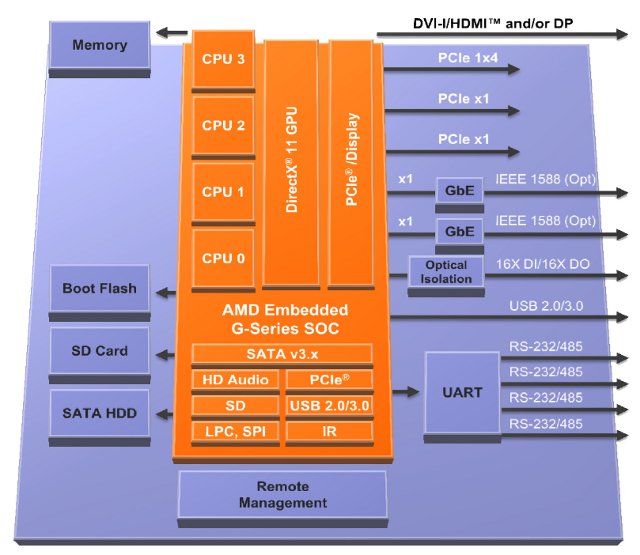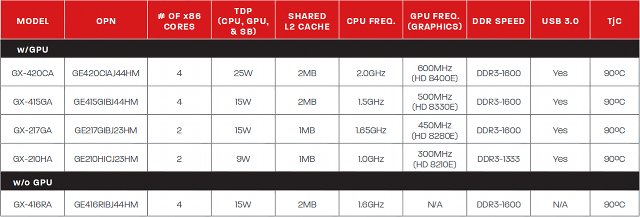In 2011, AMD launched the G-Series APUs (Accelerated Processing Unit) that combines the CPU and GPU into one chipset which then connects to a controller hub to handle I/Os, and recently the company announced AMD G-Series SoC at Design West 2013. The new solution combines a “Jaguar” CPU, a Radeon HD8000 series GPU and a controller hub into one and only SoC, further integrating functions.

Both AMD G-Series APU and SoC target embedded systems such as industrial control and automation, digital signage, electronic gaming systems, SMB storage, IP-TV, medical and network appliances, set-top boxes and more. AMD claims G-Series SOCs offer up to 113 percent improved CPU performance compared to G-Series APU, and up to a 125 percent advantage compared to the Intel Atom (Dhyrstone, EEMBC CoreMark). The platform also includes support for DirectX 11.1, OpenGL 4.2x and OpenCL 1.2 yielding up to a 20 percent graphics improvement over G-Series APUs and more than 5x advantage over Intel Atom (3DMark06 + PassMark 2D).
- SOC Design – Delivers up to 70% overall improvement over AMD G-Series APU, integrates controller Hub functional block as well as CPU+GPU+NB, and manufacturer using 28nm process technology, 24.5mm x 24.5mm BGA package. Up to 33% footprint reduction compare to APU + Controller Hub solutions.
- “JAGUAR” CPU core – Dual-core and quad-core, up to 2MB shared L2. 113% CPU performance improvement over AMD G-Series APU
- Next Generation Graphics Core – 20% compute performance improvement over AMD G-Series APU in common benchmarks, DirectX 11.1 graphics support.
- Power saving features – Power gating added to Multimedia Engine, Display Controller & NB, DDR P-states for reduced power consumption
- Memory Support – single channel DDR3 up to DDR3-1600 – 1.35V and 1.25V voltage levels supported, up to 2 UDIMMs or 2 SO-DIMMs, and ECC support
- Integrated Display Outputs – Supports two simultaneous displays, 4-lane DisplayPort 1.2, DVI, HDMI 1.4a, integrated VGA, integrated eDP or 18bpp single channel LVDS.
-
Updated I/O (Depends on exact model) – Four x1 links of PCIe Gen 2 for GPPs, one x4 link of PCIe Gen 2 for discrete GPU, 8x USB 2.0 + 2x USB 3.0, 2x SATA 2.x/3.x (up to 6Gb/s), SD Card Reader v3.0 or SDIO controller
- Industrial temperature range – -40°C to +85°C
There are 5 G-Series SoC available at launch:
- GX-420CA – Quad core @ 2.0 GHz with Radeon HD 8400E – 25W TDP
- GX-415GA – Quad core @ 1.5 GHz with Radeon HD 8330E – 15W TDP
- GX-217GA – Dual core @ 1.65 GHz with Radeon HD 8280E – 15W TDP
- GX-210HA – Dual core @ 1.0 GHz with Radeon HD 8210E – 9W TDP
- GX-416RA – Quad-Core @ 1.6 GHz without GPU – 15W TDP
Those 5 SoCs support Windows Embedded 8 and Linux.
AMD G-Series SOC platform will be available in Q2 2013 with prices ranging from $49 to $72 depending on the model.

Jean-Luc started CNX Software in 2010 as a part-time endeavor, before quitting his job as a software engineering manager, and starting to write daily news, and reviews full time later in 2011.
Support CNX Software! Donate via cryptocurrencies, become a Patron on Patreon, or purchase goods on Amazon or Aliexpress





